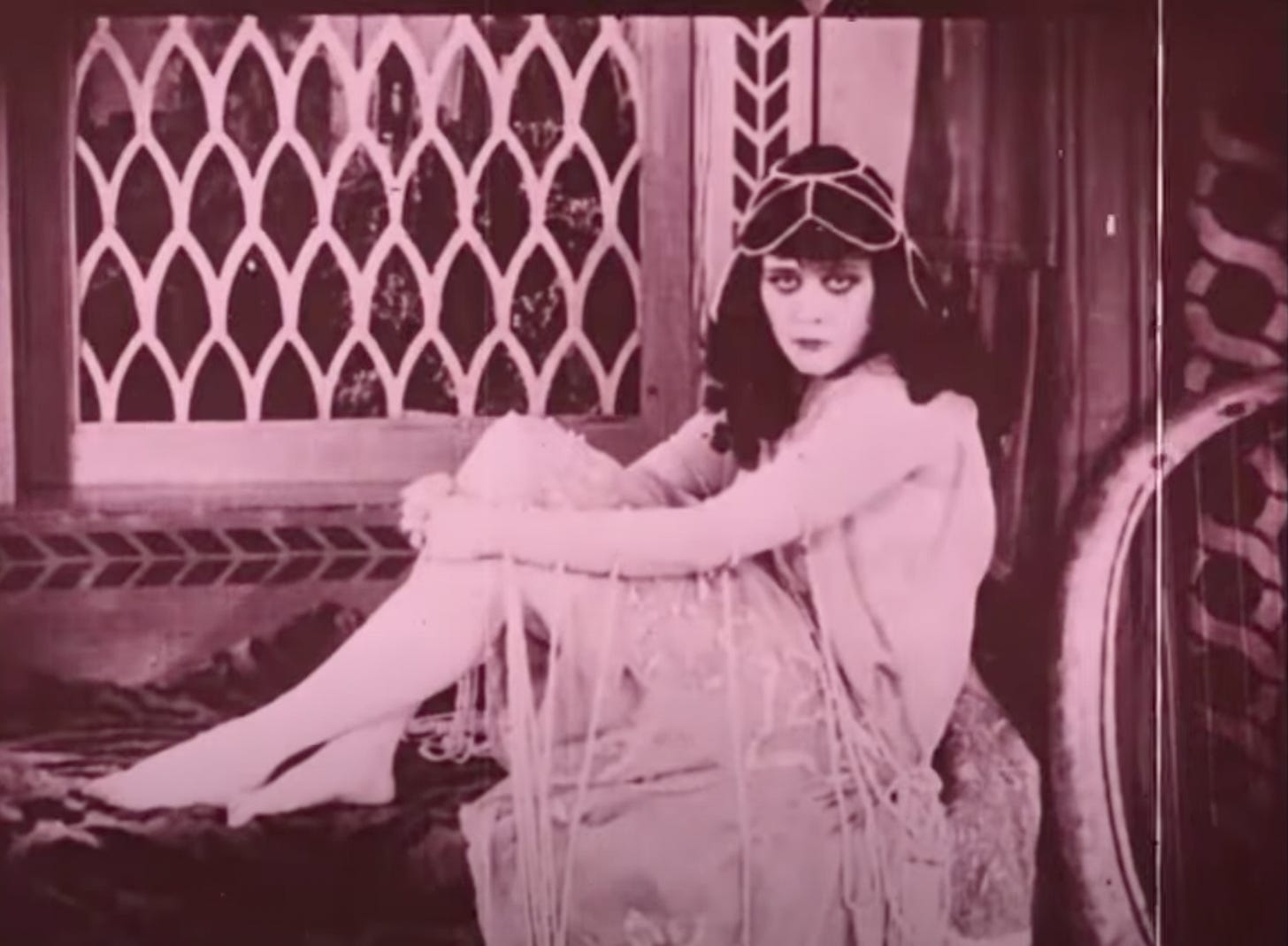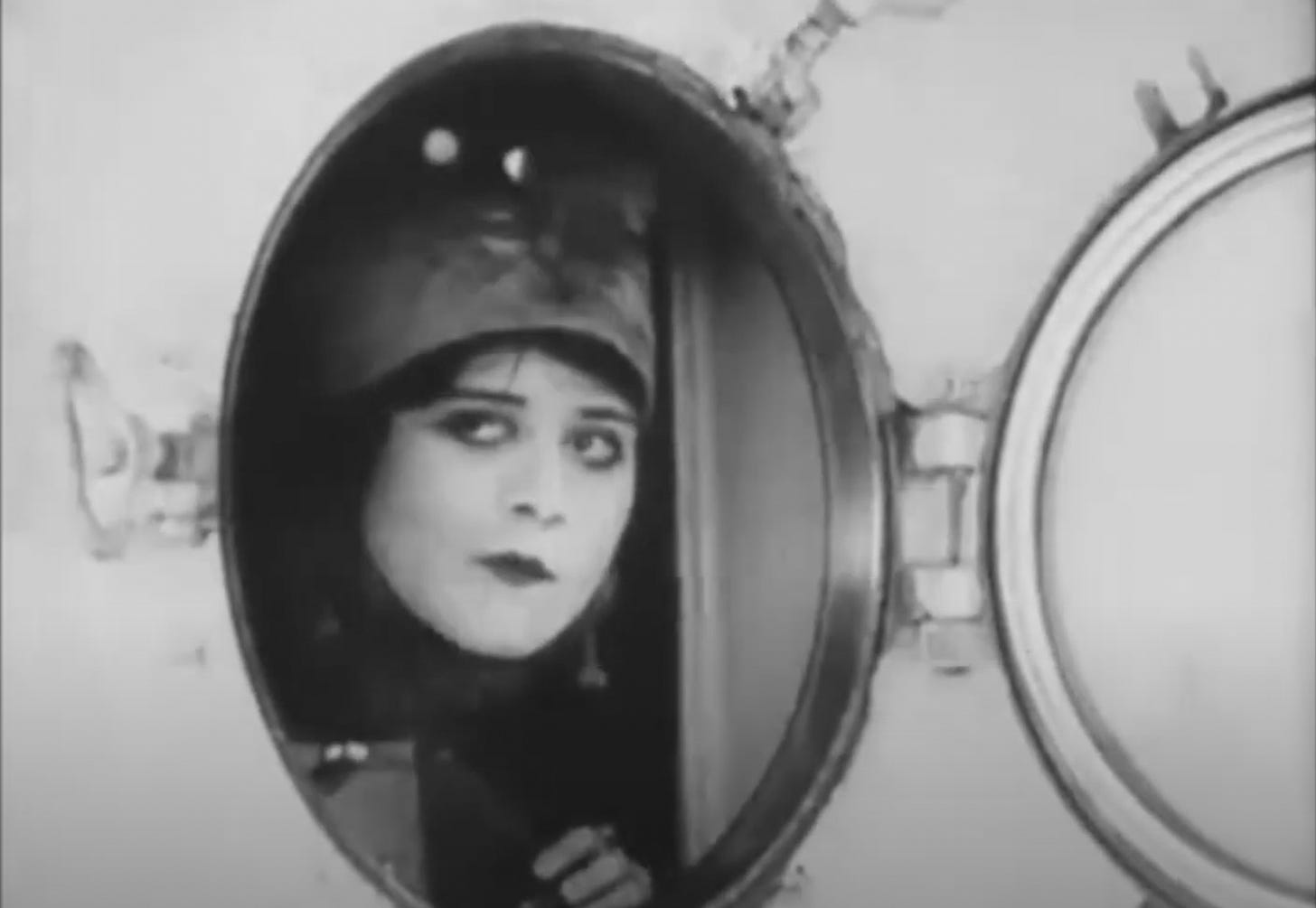A hard-working phenomenon in her day, Theda Bara was one of the top movie stars in the world from 1915 to 1920, but almost all of her 40-odd films are missing. The most sought-after of these MIA Bara features is Cleopatra (1917), a super-production where she wore very little clothing in many of her scenes. In 2023, a little over 40 seconds of footage of this picture turned up when a collector found it in a 1920s toy film projector he bought on eBay, and it shows Bara’s Cleopatra readying herself for death as soldiers riding in are intercut with her slow, stately movements in a flowing gown.
This fragment of Cleopatra gives us a glimpse of the production values of this early epic and also of Bara’s authoritativeness, how she commands the camera with her ultra-large eyes and her intense belief in what she is doing. Bara couldn’t see much of anything without a lorgnette she carried around with her, and so her hauteur on screen does sometimes look like a case of someone who cannot see at all where they are going.
Was Bara a good or bad actress? She got bad reviews sometimes in her day, and it was generally thought that she was crude, even in a time when a far broader and cruder acting was more readily accepted. In the movie that made her a star, A Fool There Was (1915), which has survived, Bara plays her Vampire gold-digger with just the right amount of humor. She seems haughty in a vaguely Eastern-European way, and Bara takes such delight in the bad behavior of her character that it is still very easy to see why she was such a success and often put into “vamp” programmers in between epics like Cleopatra and Carmen (1915) and Salome (1918).
A member of her crew started calling her “vamp” as short for The Vampire, which is how she was known in A Fool There Was, and Bara told this to a reporter, and thus a new word and attitude was added to the language. Her Vampire is first seen smiling at the camera and admiring some roses in her hand before crushing the head of one of them and then holding this crushed rose head up to us as if to say, “Isn’t ruined beauty fabulous?” More suggestive still, when one of her victims pulls a gun on her, Bara’s Vampire just smiles and gently swats the gun down with the rose in her hand before notoriously commanding, via intertitle, “Kiss me, my fool!” It is 1915, and so all Bara’s Vampire needs to do to catch her new man in her web is to flash a well-turned ankle, and this only after semi-comically hitting him on the shoulder to get his attention. The only thing that gets in her way in this movie are some fairly ugly and unflattering costumes, which the cash-strapped Bara had been required to supply herself.
The role of The Vampire in A Fool There Was had made a star of every woman who played it on stage, but Bara brings her own special brand of juicy badness to it, and this bowled over a young Bette Davis, who wrote of loving how “divinely, hysterically, insanely malevolent” Bara was on screen. Bara’s Vampire is very much a sensualist who doesn’t mind looking a little slatternly in nightgowns that fall down and long, loose hair down her back; she makes a sensual event out of stretching her arms or enjoying a cigarette. And so Bara somehow strikes a tone here that is equally comic and genuinely sexy at times, a difficult mixture, and one she made her own. She inspired so many of the movie stars that came afterward.
Bara was born Theodosia Goodman in Cincinnati, Ohio, in 1885, and she was a nice Jewish girl from a good family who loved to read and loved attention enough to try to make it in show business. She attempted for years to make a stage career and didn’t get anywhere much until spotted by director Frank Powell for A Fool There Was, at which point she was nearly 30 years old. Most of her early vehicles were shot in Fort Lee, New Jersey, and so the bookish Bara could enjoy going to museums and theater and so forth before having to come out to California to shoot the massive exteriors for Cleopatra.
Bara-mania thrived particularly on the layered and ingenious publicity campaign laid out by Fox publicists Al Selig and John Goldfrap, who had Bara recite outlandish stories about her supposedly exotic and occult background to the mainly wised-up press but let the young reporter Louella Parsons see her open a window and cry, “Give me air!” after one of their overheated press conferences. Selig and Goldfrap had the idea that the press and public being in on the joke of their Bara publicity would keep people talking about her, and it worked, for the stories they spun were repeated for decades afterward, sometimes straight, sometimes with the knowledge that they were false show-biz hoopla.
Bara was Carmen for Raoul Walsh, but Fox Studios allowed her to play heroines, too, sometimes, as in her other earliest surviving film East Lynne (1916), which was already a warhorse of a stage melodrama at the time of its release. Bara brings a welcome lusty vitality to the role that would suggest her range was not wide; she starts to have trouble when she freezes and tries to “emote” with the proper Delsarte arm movements, and she is downright awful when stricken by a heart attack at the end, but Bara has star quality to burn, nevertheless.
She had fine notices for her hoydenish Cigarette in Under Two Flags (1916), and Bara even got a positive reaction when she attempted Juliet that same year and a Camille right before her big hit as Cleopatra. Stung by a reviewer who referred to her Queen of the Nile as plump, Bara dieted down to a more sylph-like frame for her Salome (1918), which exists for now as two minutes of extremely tantalizing fragments of her writhing sensually, issuing commands with her mammoth kohl-rimmed eyes, and even rolling around on the floor. Her facial transitions do look crude here, but that must have been part of the fun of watching her. There is ample evidence to suggest that Bara was regarded as camp in her heyday long before that concept gained any mainstream recognition.
When her Fox contract was up, Bara made a lot of money on stage in a notably bad play called The Blue Flame in 1920, and she married British film director Charles Brabin in 1921. She made just one more feature film, The Unchastened Woman (1925), and looked good at age 40 with a much softer make-up and more flattering clothes than in her 1910s star period; she dominates the sort of marital story here that Gloria Swanson had made her own at this time, though Bara’s emoting in an early scene where she catches her husband cheating on her remains as hokey and 19th century as before. Bara was more at home in two comedy shorts for Hal Roach in 1926, in one of which, Madame Mystery, she glares as Oliver Hardy does a “he faw down” take, and no one did a funnier “Theda Bara” imitation than Bara herself in her later years.
She enjoyed a long and happy marriage to Brabin, stayed on in Hollywood, and was popular socially; though she sometimes spoke of making a comeback, the good-humored homebody Bara never considered this too seriously. She had made her mark. At age 66, Bara posed for some photographs for John Engstead and looks as regal and commanding as ever. There was no trouble, no scandal, nothing either to add or subtract from the legend of her stardom, which set a tone that still feels somehow modern in its double-edged way.








